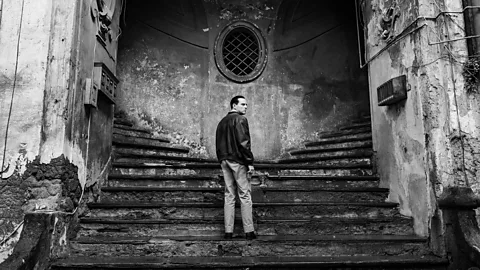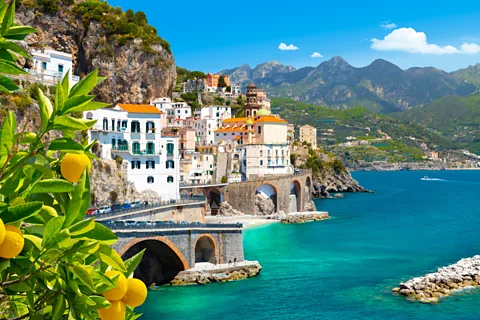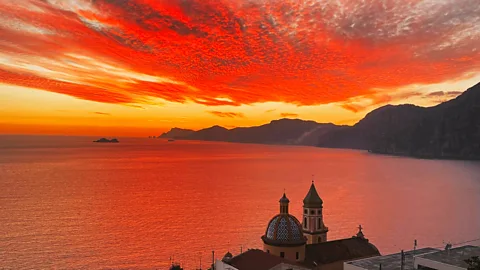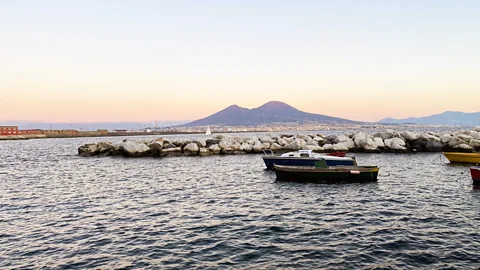Ripley's 'dolce vita' is in black and white, but the Amalfi Coast's tiny towns are in technicolour
 Netflix
NetflixDespite being a noir thriller, Netflix's Ripley brings new life to Italy's romanticised notion of la dolce vita. Here's how to experience it in the Amalfi Coast's sleepy villages.
La dolce vita, or "the sweet life" – popularised by Federico Fellini's eponymous 1960 film – is the single phrase that sold Italy as a rainbow-coloured land where dreams are made.
It's an ephemeral term that immediately evokes an unmistakable aesthetic: neon-orange Aperol Spritzes, Vespa scooters, cappuccinos in the piazza, Mediterranean expanses of sea and sky – images that have long fuelled the imagination of filmmakers, authors and, most recently, social media influencers.
This year has given us yet another serving of "la dolce vita" with a sprinkle of something sour: Ripley, the newest rendition of Patricia Highsmith's 1955 crime novel, The Talented Mr. Ripley has just hit Netflix. Written, executive produced and directed by Academy Award winner Steven Zaillian (The Irishman) and starring Irish actor Andrew Scott (Sherlock, Fleabag), the series updates Hollywood's 1999 star-studded film, following the original's similarly oneiric trail – from the Amalfi Coast's crags to Venice's lagoon – while telling a story of a sociopathic fraudster whose obsession descends to unfettered depths. But Zaillian's Ripley is Hitchcock-inspired Italy noir; the country's legendary technicolour landscapes are literally painted in drab black and white. For once, viewers are treated to the sweet life in Italy where everything looks sublime, but terrible things happen.
As Ripley freshly whets our appetite for all things Italian, it simultaneously begs the age-old question: does the fabled "dolce vita" even exist? And how can it be experienced today?
Visit the Amalfi Coast
In Ripley, the namesake protagonist, Tom, takes on a con job to persuade a rich man's son, Dickie Greenleaf, to return home from his prolonged Italian vacation.
Leaving his crummy New York City brownstone for what turns into a romp across Italy, Tom's first stop is the village of Atrani on the Amalfi Coast.
 Getty Images
Getty ImagesMuch of the plot centres on this small corner of the country; indeed, nowhere better embodies "the dolce vita" vision than this region's rugged beauty, where lemon orchards flank medieval churches perched on scenic cliffs, and vintage cars lay nestled in pastel-coloured alleyways.
In many ways, the Amalfi Coast feels like a time capsule; perhaps that's why it's so synonymous with the "sweet life". As a product of Fellini's own film, which was famously set in Rome, the iconography of the "dolce vita" concept is itself intrinsically imbued with mid-20th-Century imagery. The 1950s and '60s have long been seen as a "golden era" when Italy was suspended between two ages – its pre-war state as a land of tradition, rural life, religious devotion, decaying artistic glories, and a post-war industrial boom that saw Fiat 500, Vespa 98 scooters, Olivetti typewriters and Moka coffee machines. Rome eventually embraced modernity while the Amalfi Coast prefers things the way they were; Rome's chaos rises to the surface while the Amalfi Coast's problems simmer beneath the postcard veneer.
Ripley itself is set in the same year as La Dolce Vita, each exquisite historical set detail wrought to perfection, from postage stamps to lire notes. Italian nationals of a certain age will inevitably suffer pangs of nostalgia to witness relics of the bygone era, like luxurious train cars and a soundtrack peppered with music by beloved Italian 1960s pop star Mina.
Nowadays, in Positano and Amalfi, visitors are spoon fed a pre-packaged "dolce vita" – the ancient towns dominated by restaurants and hotels catered to satisfying expectations. Plasticised multilingual menus abound and tourists pack the narrow cobblestoned streets, blocking out the most stunning panoramas – every corner turned into someone's Instagram shoot. In winter, these cities effectively turn into liminal spaces: the streets empty and souvenir stalls lay dormant like closed-down rides at amusement parks, ready to entertain the throng of visitors once the high season kicks off again.
It's in the Amalfi Coast's smaller localities, like the far less-touristed fishing villages of Praiano and Atrani – where a more candid version of "the dolce vita" still exists.

In Praiano, heading east from Positano, locals gather at the Bar del Sole to sip cappuccino before noon and Campari before dusk. Neapolitan pop music plays on boomboxes and shops sell colourful ceramic tiles that locals display on the many homes peppered along the winding Via Masa down to the town's tiny beach.
Once Sunday arrives, the bell of the Unesco-listed blue-and-white cupolaed Church of San Gennaro summons the town to the small square that overlooks the impossible, rugged beauty of the coast. Tourists are merely a part of the picture: Praiano's community life is alive and well. At local eateries such as chef Gennaro Galani's seafood restaurant Saghir or the Trattoria San Gennaro, locals are just as much of a presence as visitors.
Take a stomach-wrenching bus voyage to Amalfi on the meandering clifftop SS163 state road with 300m death drops, then walk 800m east through the Luna Rossa car park to reach Atrani. The smallest municipality in Italy, Atrani has protected its traditions as tightly as it envelops its small beach, which remains free from the mass of tourists descending on Positano and Amalfi's shorelines.
It's a magical place in many ways – in Ripley, Dickie's girlfriend, Marge, spends her time trying (and failing) to capture its essence in a book. In the real world, Atrani sheltered the Dutch artist MC Escher, who used its labyrinths of mesmerising staircases as inspiration for some of his works.
Italy's staircases are a common symbol throughout the series, emblematic of Tom's constant uphill social and emotional struggle, and very much part of daily life for locals and visitors today. For those strong of heart, it's a 750-step climb to reach Atrani's crown jewel: the Sanctuary of Santa Maria del Bando, a Baroque chapel perched atop a cliff overlooking the bay. Venturing up to Dickie's Moorish-styled mansion (Villa Torricella), however, will require a boat ride – it's actually in Capri, and bookable via Airbnb.
Naples: "The dolce vita's" darker side
Behind the dolce often lies the amaro – the bitter. And Italy, alas, is not free from that. The country has long suffered from many troubles, from a north-south economic disparity to unemployment, crime and disillusionment.
 Alamy
AlamyMany of those working to sustain tourists' "dolce vita" dreams are themselves young graduates, forced into low-paying service jobs due to lack of opportunities.
The new Ripley frequently pinches us in the midst of our "dolce vita" daydreams, highlighting the cracks in the surface – much like Fellini's own film in 1960. Compared to the more postcard-perfect 1999 original, the newer incarnation is much darker. It references Italian bureaucracy, crime and even Naples's infamous local Mafia (Camorra). Tom is scammed by an unscrupulous taxi driver as soon as he sets foot in Napoli Centrale train station and is approached by a two-bit mafioso in a piazza in Atrani. As Tom goes about his own nefarious deeds, he is constantly eyed warily by locals, who have caught the whiff of another huckster among them. Much of the dialogue between Tom and Dickie centres around the art of the con, as Tom toys with his prey. Ironically, Dickie can smell the mafioso a mile away, but tragically fails to grasp the extent of Tom's dark genius. The series often references painter Caravaggio, and it feels much like one of his paintings – baroque, sensual, leaning heavily on a chiaroscuro (literally "light-dark) showing Italy's stark contrasts.
When romanticising Italy, people often offload all its sins to one place: Naples, long renowned for its crime and garbage problems. But Amalfi is set in the same cultural context as Naples, a city synonymous with several of "the dolce vita's" own staples, from pizza to espresso.
It's a fairy tale place in many ways, with Baroque palaces set against the backdrop of Mount Vesuvius. But it airs its dirty laundry just like the sheets hanging on the clotheslines in its streets. It's a city that has suffered devastating economic and social woes, and where many of its most colourful traditions – from street art to local folklore – were born as a response to such oppression.
To ignore or overlook Naples – a jewel of a city, despite its centuries-old woes – is to fundamentally misunderstand Italy and "the dolce vita" from the outset.
 Andrea Carlo Martinez
Andrea Carlo Martinez"Doing nothing is sweet"
While the dolce vita dream may have a clearly defined aesthetic, it also has a distinct modus operandi – dolce far niente, or "doing nothing is sweet". Indeed, it is the "doing nothing" that is the main driver of Ripley's plot, as Dickie's father worries about his son's inertia.
Owing to its balmier climate and longstanding agricultural society, life in Italian villages was often slow and revolved around the lunch table. Golden Age Cinecittà-Hollywood packaged this lifestyle into a box with a "dolce vita" sticker. And now it's been adopted as Italy's unofficial way of living, and a lucrative selling point.
But the truth is, you don't need to go all the way to Amalfi to find "the dolce vita" – you can find hints of it almost anywhere in the country, even in the larger cities. A quick espresso at the bar, an aimless vasca (lap) around the piazza, a lunch that takes four hours from antipasto to amaro.
"The dolce vita" is about enjoying the small pleasures of everyday living, in its full spontaneity. In Ripley, Marge's choice to write an entire book about Atrani is something of an inside joke – not much happens in that tiny burg, then or now. Locals laze in piazzas, haul their groceries up staircases; visitors wander about in search of excitement, stopping just short of hiking up that last set of stairs, contenting themselves with a gelato and aperitivo in the piazza as they gaze out at the ink blue Gulf of Naples.
Adopting the "dolce far niente" mindset can be a radical act at times. Learn to let go and embrace the silence. Or the chaos.
